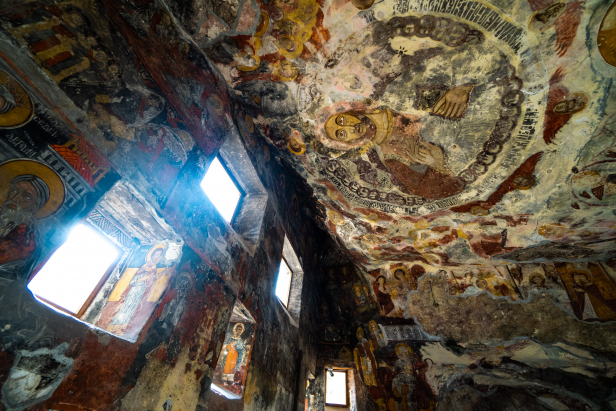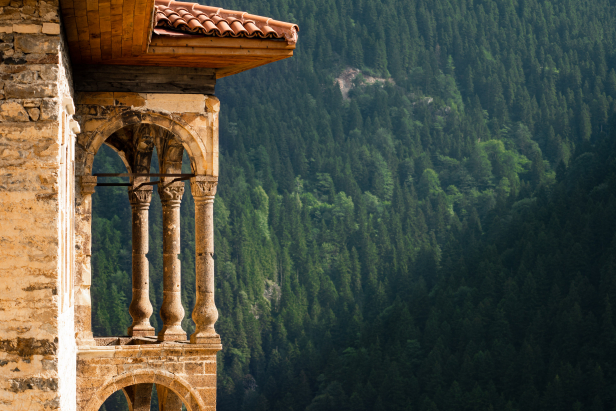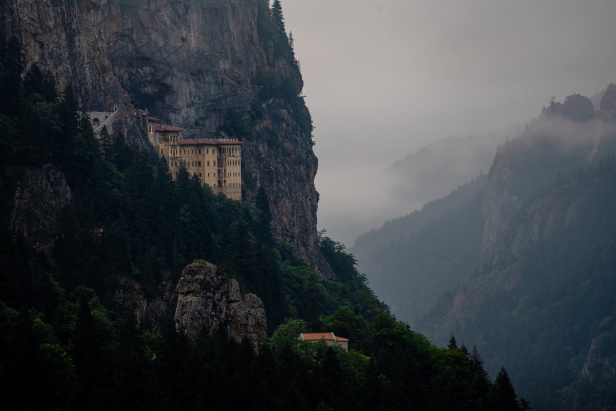Panagia Sumela Monastery
(Sümela Manastırı)
/ By Josh
Cost: 125+10TL
(Müze Card Accepted, +10TL for shuttle from lower parking lot to Museum)
Great for: Byzantine History, Pontic Greek, Orthodox Church, Natural Beauty, Monasticism
Clinging to the face of a sheer cliff some 300 meters above the valley floor and home to some of the country’s finest religious art, Panagia Sumela Monastery has become one of Turkey’s most iconic destinations. Whether you’re catching a glimpse of the ancient building through the branches of the forest below or exploring the churches and cells within the complex, Sumela Monastery is a uniquely beautiful sight.
The popular name “Sumela” (often Sümela in Turkish) is believed to come from the Greek Sou + Mela, meaning Black Mountain and is a shortened version of Panagia Sumela Monastery, Panagia being a name commonly given to churches dedicated to the Mother Mary, meaning “all” or “most-holy”. The stream which flows beneath the monastery still bears the name Meryemana, or “Mother Mary”, in Turkish, though officially it is named the Altıntaş Stream.
Why Visit?
While a visitor’s first glimpse of Panagia Sumela Monastery is usually from below in the valley, or from the viewpoint to the south of the monastery, the first building you will come to is actually the Church of St Barbara (Aya Varvara in Turkish), built on a rocky spur a short distance from the rest of the Sumela complex. The church is in a good state of repair (thanks to restoration efforts), though the surrounding buildings have been reduced to bare foundations. The Church of St Barbara is a simple rectangular building with a deep semi-circular apse on its east end. The door is set rather oddly in the center of the south wall rather than in the west wall in axis with the apse.


A short walk through the spruce forest from St Barbara brings you to the entrance to the museum proper with a ticket booth built at the foot of an aqueduct built against the cliff face. A stone stair brings you to a doorway and a short passage into the monastery courtyard hidden behind the buildings you saw from below. Despite Sumela’s incredible height, it actually occupies a fairly small space under the overhang of the cliffs.
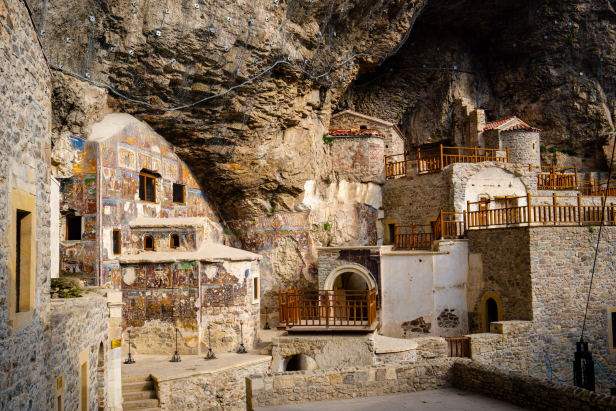
Sumela shares many design similarities to Vazelon Monastery, which was established a few decades prior, both centered on a natural cave at the foot of a high cliff with a high façade-like outer building creating a courtyard behind it where the cave church sits. Sumela had a bell tower (now collapsed), as well as a library, numerous chapels, an ayazma (sacred spring), kitchens, refectory, and numerous rooms for monks and guests.
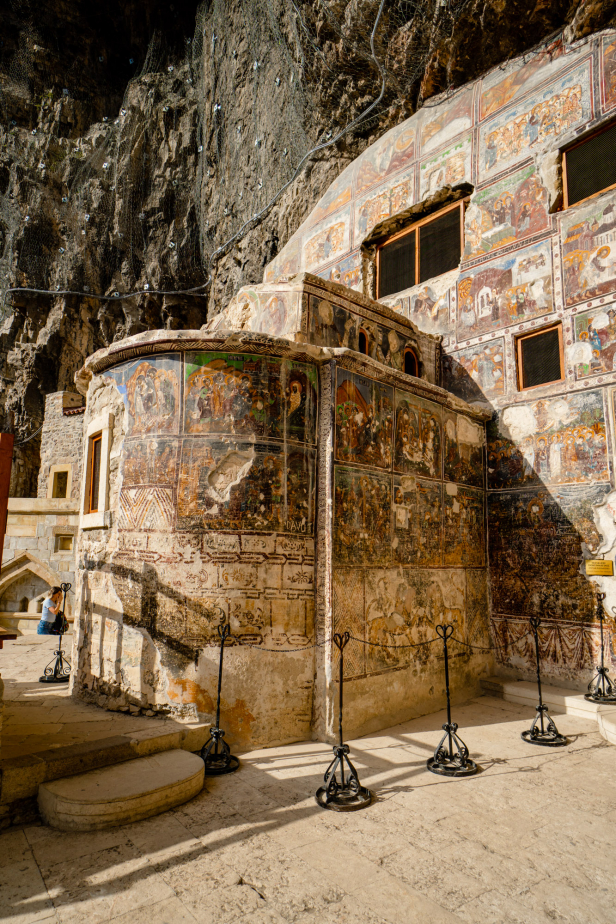
At the center of the complex and immediately attracting the attention of any visitor is the cave church. A wall built across the mouth of the cave forms the interior of this unusual church. The church is covered in frescoes both inside and out. The cave faces west rather than east, so an apse was built into the enclosing wall, jutting out into the monastery courtyard. The cave is dominated by a pair of particularly large frescoes, one depicting the Pantocrator (Christ as ruler), and another of the Panagia (Mary with the child Christ on her lap, while her hands are lifted in the orans position). These frescoes face east rather than the usual west as the slope of the natural roof would make them upside down and the entrance to the cave church is in the east next to the apse.
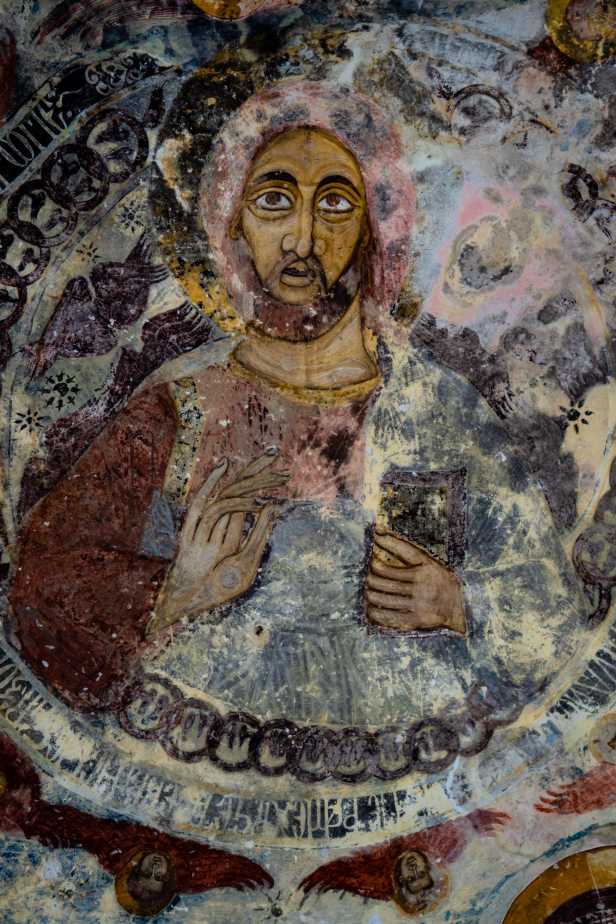
These two main frescoes are surrounded by other smaller frescoes depicting various saints as well as biblical scenes. The majority of the frescoes of the cave church and the other chapels have been dated to the 18th and 19th centuries, though the oldest belong to the 14th century.
Most of the wooden portions of the monastery have not yet been restored so the outer buildings are mostly closed to visitors still. One of the outer rooms that is open to visitors has been used to display historic photographs and photographs of restoration work. A screen presents a brief history of the monastery giving particular importance to how well the Ottomans treated the monastery as well as an unfortunate misrepresentation of Christianity saying that “In Christianity, it is believed that Jesus Christ did not die but rose to the heavens.”
History:
The origins of Panagia are unclear. According to the popular account, the monastery was founded by a pair of Athenian monks, Barnabas and Sophronios who saw a vision in which the Mother Mary told them where to find an icon painted by St Luke, hidden in a cave in the distant mountains of Pontus. After the long and arduous journey they discovered the icon and established a monastery at the site. The common date given for the founding of the monastery by Barnabas and Sophronios is around 380, a few decades after the Edict of Milan which officially legalized Christianity in the Roman Empire.
While Sumela Monastery was founded after the nearby Vazelon Monastery (founded between 270 and 317), it quickly came to be the foremost monastery in the region. Like its predecessor Vazelon, Sumela began as a simple cave church, growing over the years and centuries, expanding to become a large and even grand complex. Sumela was expanded in the 6th century by Byzantine Emperor Justinian I who also built the Hagia Sophia in its current form. The monastery also suffered raids and fires, with the following reconstructions bringing changes to the shape of the ever-evolving complex.
Subscribe to The Art of Wayfaring
Today’s form can be largely traced back to the 13th century during a period in which the monastery enjoyed the patronage of the Grand Komnenoi of the Empire of Trebizond, a Byzantine successor state following the seizing of Constantinople by the Latins of the Fourth Crusade. Even after Constantinople was restored to the Byzantines, the monastery continued to enjoy special favour from the rulers and the monastery was expanded to house a large number of monks, priests, and an extensive library.
After the Fall of Constantinople in 1453 and the Fall of Trebizond to the Ottoman Turks, Sumela Monastery received protected status from Sultan Mehmet II and his successors and continued to function, relying on its land holdings rather than royal patronage for funding. The monastery remained an important part of the social fabric of the Pontic Greeks, serving as a center of religious life as well as education until the beginning of the 20th century.
In 1923, following the collapse of the Ottoman Empire and the establishment of the Turkish Republic, the nations of Greece and Turkey agreed on a population exchange which saw the forced movement of some 1.6 million people from their lands. Muslims from Greece were sent to Turkey while Christian Greeks, including the Pontic Greeks of Trabzon, were sent to Greece, bringing an end to over 1500 years of tradition in Panagia Sumela Monastery.
Fearing looters, the monks of Sumela buried some of the monastery’s treasures, and, eight years later, returned to retrieve them. In later years a new monastery was founded in Greece called the Panagia Soumela of Mount Vermion, near the town of Kastania in Macedonia.
Abandoned to the elements, a fire, and looters, the original Sumela Monastery languished until it was turned into a museum. Over the years efforts have been made to shore up the ancient buildings and clean and preserve the beautiful frescoes. While these efforts have undoubtedly helped preserve the site, some efforts have been lazy, keeping a building from collapse but destroying any historic authenticity. For the most part restoration efforts at Sumela have been above average. The Museum was closed again until 2021 while work was done to stabilize the cliff above as debris had begun to fall onto the buildings. While the wire netting is not pretty it has been a necessary precaution to protect visitors and buildings alike.
Subscribe to The Art of Wayfaring
How To Get There
Public Transport
In the summer months there is a dolmuş (large passenger van) running between the Trabzon bus terminal and Sumela, though in the off season you will have to use public transit to the Town of Maçka and take a taxi from there.
Tour Bus
Sumela Monastery is the top destination in the area and going to be included in any tour package. There are lots of different tours to choose from with different degrees of freedom and pacing depending on which companies you look at. If you’re not confident pre-booking online, you can always visit one of the dozen or so offices scattered around downtown Trabzon to see what they have to offer.
Car
By car head south from the east end of the city on the D885/E97 highway towards the town of Maçka. As you approach Maçka make sure to not go into the tunnel but turn off into the town. On the far side of the town take a left turn following the giant brown signs marked for Sümela Manastırı. Follow this road for 16 kms till you reach the parking lot below Sumela Monastery. From here you will need to pay to take a shuttle up to the monastery itself. It used to be that you could hike from the restaurants and cafes below directly up to the monastery but when we visited this route was closed and all visitors had to take the shuttle.
For more about car rental and driving in Turkey make sure to read our full drivers guide.
Where To Stay
While there may be a higher concentration of hotels in the towns and city center of Trabzon, the best way to experience the natural beauty of Trabzon Province is to find a boutique hotel or guest house in the countryside. Whether you stay in the Yayla (seasonal alpine villages), in one of the riverside guesthouses overlooking the Maçka Stream, or in any of the other guest houses scattered throughout the hills and forests, this will be your best chance at taking in the quiet of the natural setting.
Other Tips
Planning on visiting Sümela Monastery? Make sure to check out Vazelon and Kuştul Monasteries which together made up the three great monasteries of the Maçka Valley. And don’t forget to see our guides to the sights of the Black Sea Region!
Subscribe to The Art of Wayfaring
Have any tips or info to add? Spot any mistakes? We’d love to hear about it.

